Analysis of Lego's Market and Product Development Strategies
VerifiedAdded on 2023/04/21
|6
|1169
|302
Case Study
AI Summary
This case study report examines Lego's market and product development strategies. It analyzes market opportunities in domestic and international markets, considering globalization, technological advancements, and evolving consumer preferences. The report explores potential strategies such as product extension through innovation, exemplified by the development of electrical hangers. To mitigate financial risks, the report suggests joint ventures with companies like IKEA. Furthermore, the report emphasizes the importance of in-house technology development, dedicated teams, and continuous employee training to boost product effectiveness and consumer satisfaction. The implementation involves cost management, creative freedom, and a focus on quality and service across all departments, aiming for global market expansion and competitive advantage. The case study highlights the need for adaptability and strategic partnerships for sustained growth.
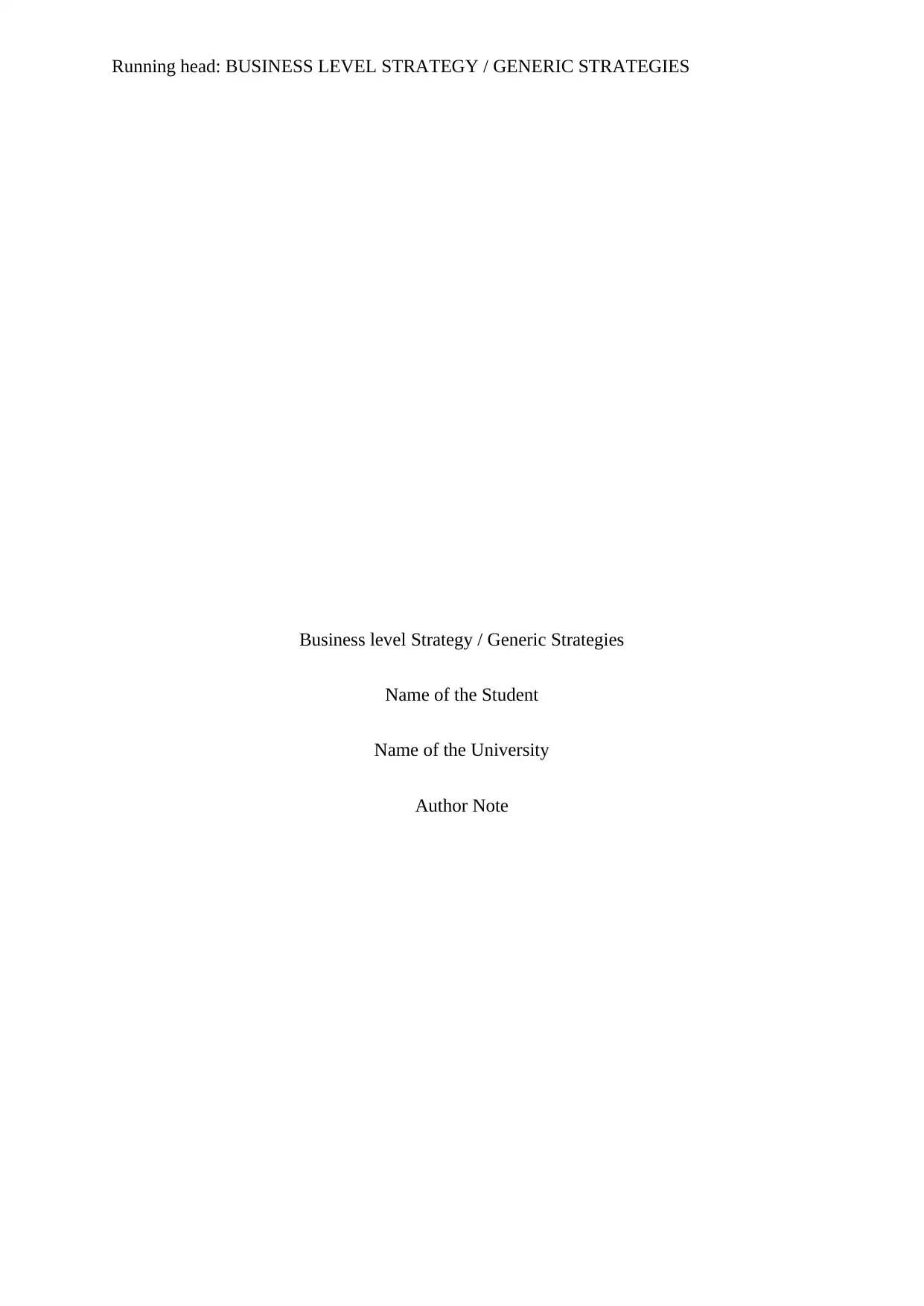
Running head: BUSINESS LEVEL STRATEGY / GENERIC STRATEGIES
Business level Strategy / Generic Strategies
Name of the Student
Name of the University
Author Note
Business level Strategy / Generic Strategies
Name of the Student
Name of the University
Author Note
Paraphrase This Document
Need a fresh take? Get an instant paraphrase of this document with our AI Paraphraser
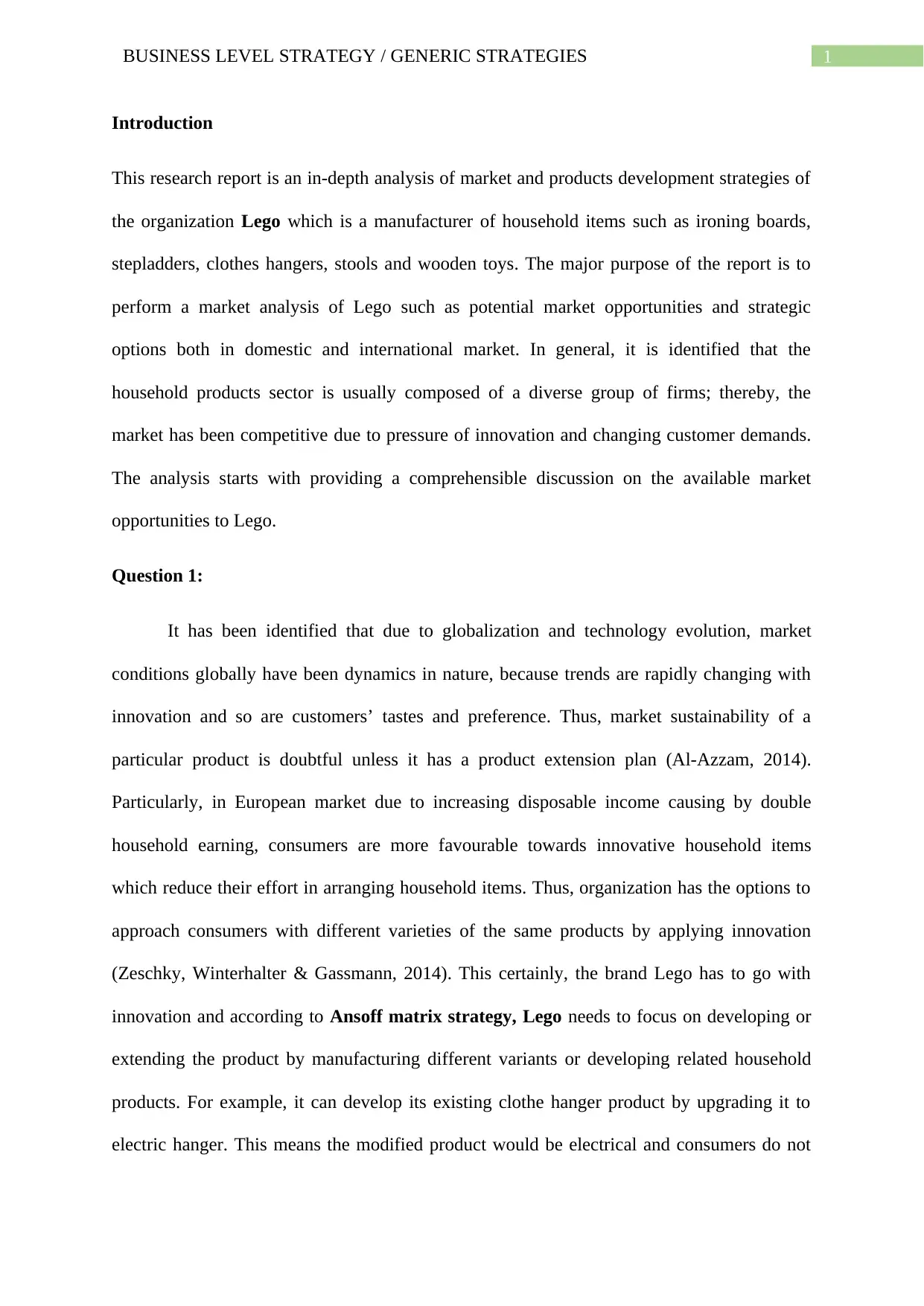
1BUSINESS LEVEL STRATEGY / GENERIC STRATEGIES
Introduction
This research report is an in-depth analysis of market and products development strategies of
the organization Lego which is a manufacturer of household items such as ironing boards,
stepladders, clothes hangers, stools and wooden toys. The major purpose of the report is to
perform a market analysis of Lego such as potential market opportunities and strategic
options both in domestic and international market. In general, it is identified that the
household products sector is usually composed of a diverse group of firms; thereby, the
market has been competitive due to pressure of innovation and changing customer demands.
The analysis starts with providing a comprehensible discussion on the available market
opportunities to Lego.
Question 1:
It has been identified that due to globalization and technology evolution, market
conditions globally have been dynamics in nature, because trends are rapidly changing with
innovation and so are customers’ tastes and preference. Thus, market sustainability of a
particular product is doubtful unless it has a product extension plan (Al-Azzam, 2014).
Particularly, in European market due to increasing disposable income causing by double
household earning, consumers are more favourable towards innovative household items
which reduce their effort in arranging household items. Thus, organization has the options to
approach consumers with different varieties of the same products by applying innovation
(Zeschky, Winterhalter & Gassmann, 2014). This certainly, the brand Lego has to go with
innovation and according to Ansoff matrix strategy, Lego needs to focus on developing or
extending the product by manufacturing different variants or developing related household
products. For example, it can develop its existing clothe hanger product by upgrading it to
electric hanger. This means the modified product would be electrical and consumers do not
Introduction
This research report is an in-depth analysis of market and products development strategies of
the organization Lego which is a manufacturer of household items such as ironing boards,
stepladders, clothes hangers, stools and wooden toys. The major purpose of the report is to
perform a market analysis of Lego such as potential market opportunities and strategic
options both in domestic and international market. In general, it is identified that the
household products sector is usually composed of a diverse group of firms; thereby, the
market has been competitive due to pressure of innovation and changing customer demands.
The analysis starts with providing a comprehensible discussion on the available market
opportunities to Lego.
Question 1:
It has been identified that due to globalization and technology evolution, market
conditions globally have been dynamics in nature, because trends are rapidly changing with
innovation and so are customers’ tastes and preference. Thus, market sustainability of a
particular product is doubtful unless it has a product extension plan (Al-Azzam, 2014).
Particularly, in European market due to increasing disposable income causing by double
household earning, consumers are more favourable towards innovative household items
which reduce their effort in arranging household items. Thus, organization has the options to
approach consumers with different varieties of the same products by applying innovation
(Zeschky, Winterhalter & Gassmann, 2014). This certainly, the brand Lego has to go with
innovation and according to Ansoff matrix strategy, Lego needs to focus on developing or
extending the product by manufacturing different variants or developing related household
products. For example, it can develop its existing clothe hanger product by upgrading it to
electric hanger. This means the modified product would be electrical and consumers do not
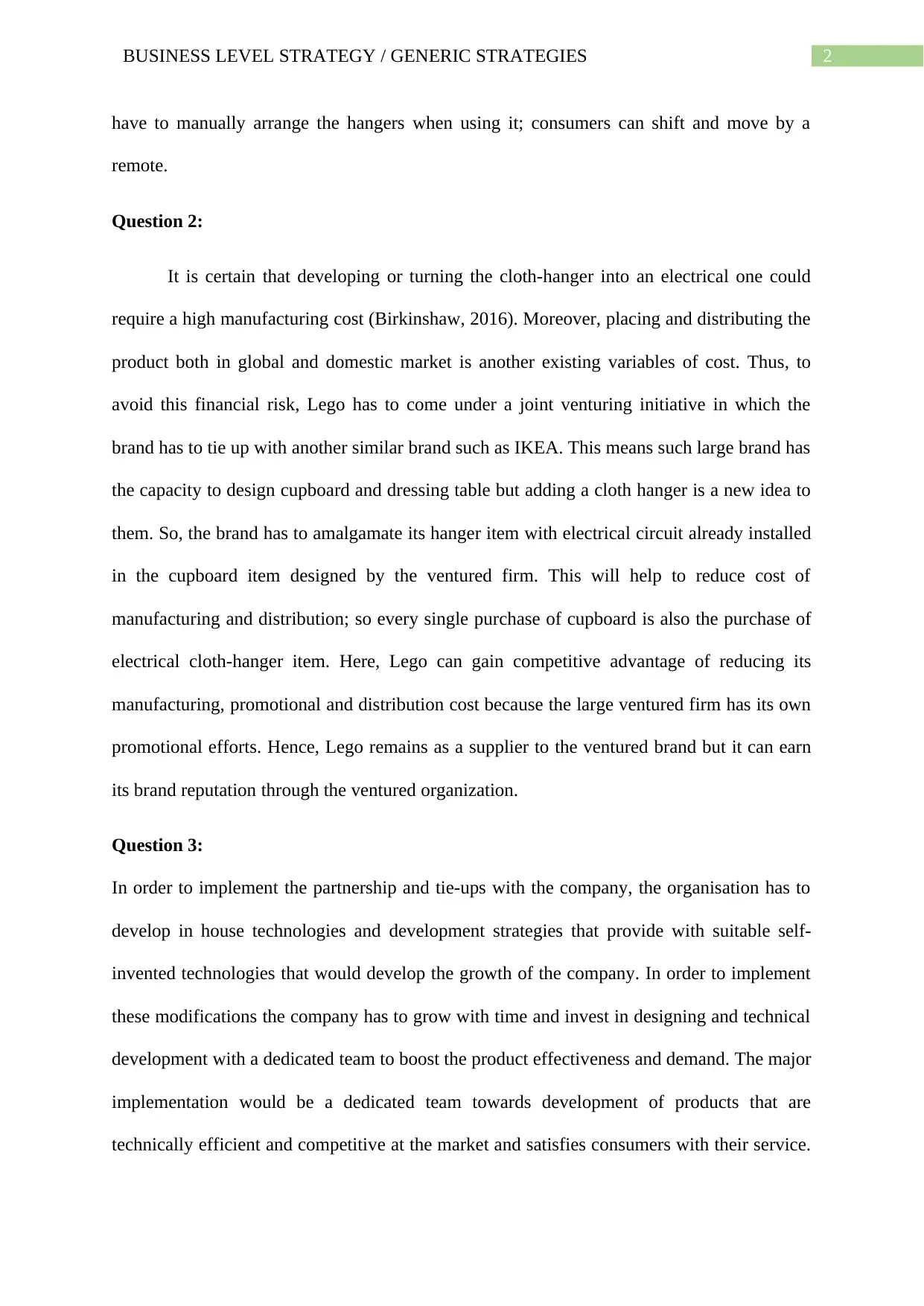
2BUSINESS LEVEL STRATEGY / GENERIC STRATEGIES
have to manually arrange the hangers when using it; consumers can shift and move by a
remote.
Question 2:
It is certain that developing or turning the cloth-hanger into an electrical one could
require a high manufacturing cost (Birkinshaw, 2016). Moreover, placing and distributing the
product both in global and domestic market is another existing variables of cost. Thus, to
avoid this financial risk, Lego has to come under a joint venturing initiative in which the
brand has to tie up with another similar brand such as IKEA. This means such large brand has
the capacity to design cupboard and dressing table but adding a cloth hanger is a new idea to
them. So, the brand has to amalgamate its hanger item with electrical circuit already installed
in the cupboard item designed by the ventured firm. This will help to reduce cost of
manufacturing and distribution; so every single purchase of cupboard is also the purchase of
electrical cloth-hanger item. Here, Lego can gain competitive advantage of reducing its
manufacturing, promotional and distribution cost because the large ventured firm has its own
promotional efforts. Hence, Lego remains as a supplier to the ventured brand but it can earn
its brand reputation through the ventured organization.
Question 3:
In order to implement the partnership and tie-ups with the company, the organisation has to
develop in house technologies and development strategies that provide with suitable self-
invented technologies that would develop the growth of the company. In order to implement
these modifications the company has to grow with time and invest in designing and technical
development with a dedicated team to boost the product effectiveness and demand. The major
implementation would be a dedicated team towards development of products that are
technically efficient and competitive at the market and satisfies consumers with their service.
have to manually arrange the hangers when using it; consumers can shift and move by a
remote.
Question 2:
It is certain that developing or turning the cloth-hanger into an electrical one could
require a high manufacturing cost (Birkinshaw, 2016). Moreover, placing and distributing the
product both in global and domestic market is another existing variables of cost. Thus, to
avoid this financial risk, Lego has to come under a joint venturing initiative in which the
brand has to tie up with another similar brand such as IKEA. This means such large brand has
the capacity to design cupboard and dressing table but adding a cloth hanger is a new idea to
them. So, the brand has to amalgamate its hanger item with electrical circuit already installed
in the cupboard item designed by the ventured firm. This will help to reduce cost of
manufacturing and distribution; so every single purchase of cupboard is also the purchase of
electrical cloth-hanger item. Here, Lego can gain competitive advantage of reducing its
manufacturing, promotional and distribution cost because the large ventured firm has its own
promotional efforts. Hence, Lego remains as a supplier to the ventured brand but it can earn
its brand reputation through the ventured organization.
Question 3:
In order to implement the partnership and tie-ups with the company, the organisation has to
develop in house technologies and development strategies that provide with suitable self-
invented technologies that would develop the growth of the company. In order to implement
these modifications the company has to grow with time and invest in designing and technical
development with a dedicated team to boost the product effectiveness and demand. The major
implementation would be a dedicated team towards development of products that are
technically efficient and competitive at the market and satisfies consumers with their service.
⊘ This is a preview!⊘
Do you want full access?
Subscribe today to unlock all pages.

Trusted by 1+ million students worldwide
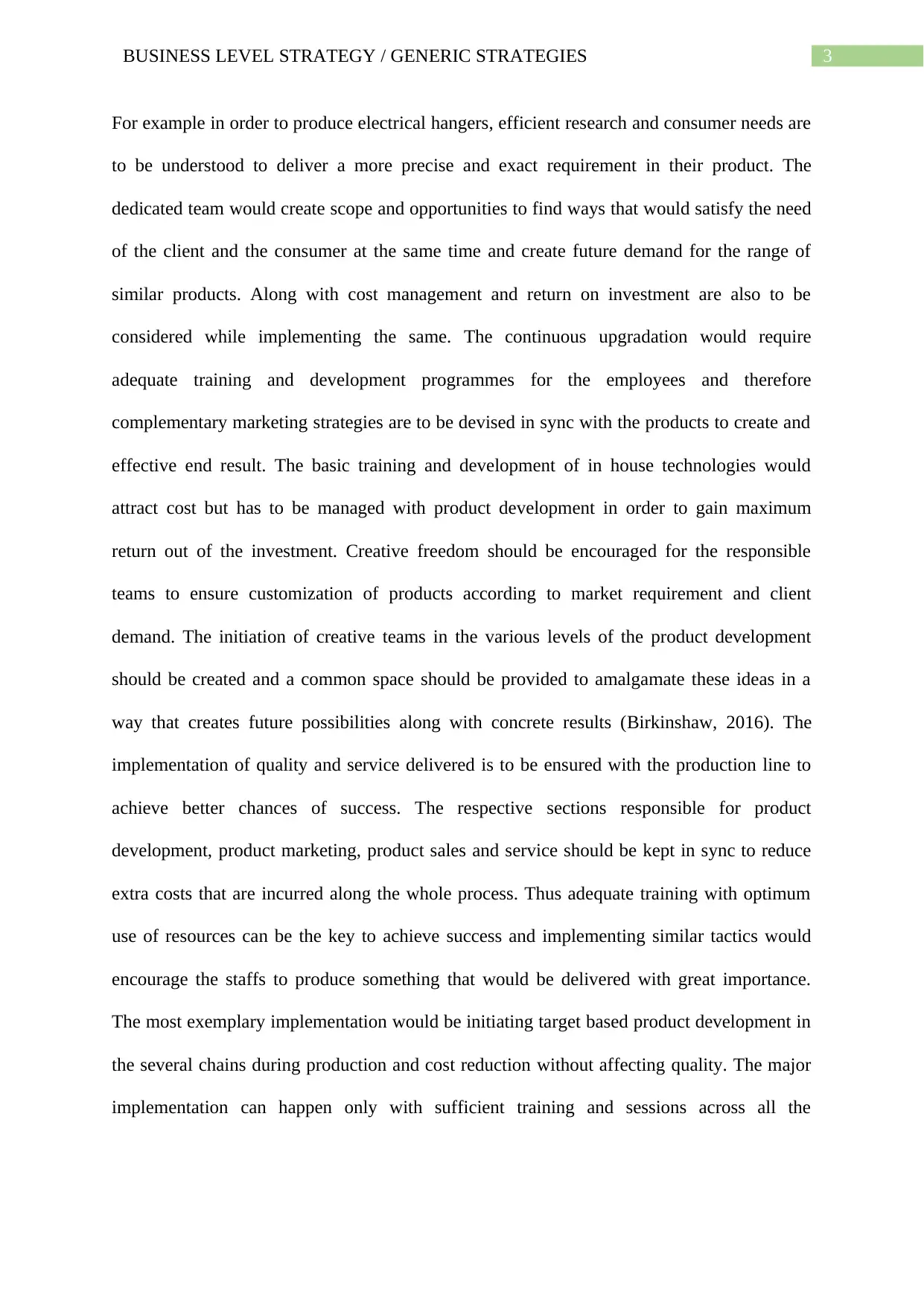
3BUSINESS LEVEL STRATEGY / GENERIC STRATEGIES
For example in order to produce electrical hangers, efficient research and consumer needs are
to be understood to deliver a more precise and exact requirement in their product. The
dedicated team would create scope and opportunities to find ways that would satisfy the need
of the client and the consumer at the same time and create future demand for the range of
similar products. Along with cost management and return on investment are also to be
considered while implementing the same. The continuous upgradation would require
adequate training and development programmes for the employees and therefore
complementary marketing strategies are to be devised in sync with the products to create and
effective end result. The basic training and development of in house technologies would
attract cost but has to be managed with product development in order to gain maximum
return out of the investment. Creative freedom should be encouraged for the responsible
teams to ensure customization of products according to market requirement and client
demand. The initiation of creative teams in the various levels of the product development
should be created and a common space should be provided to amalgamate these ideas in a
way that creates future possibilities along with concrete results (Birkinshaw, 2016). The
implementation of quality and service delivered is to be ensured with the production line to
achieve better chances of success. The respective sections responsible for product
development, product marketing, product sales and service should be kept in sync to reduce
extra costs that are incurred along the whole process. Thus adequate training with optimum
use of resources can be the key to achieve success and implementing similar tactics would
encourage the staffs to produce something that would be delivered with great importance.
The most exemplary implementation would be initiating target based product development in
the several chains during production and cost reduction without affecting quality. The major
implementation can happen only with sufficient training and sessions across all the
For example in order to produce electrical hangers, efficient research and consumer needs are
to be understood to deliver a more precise and exact requirement in their product. The
dedicated team would create scope and opportunities to find ways that would satisfy the need
of the client and the consumer at the same time and create future demand for the range of
similar products. Along with cost management and return on investment are also to be
considered while implementing the same. The continuous upgradation would require
adequate training and development programmes for the employees and therefore
complementary marketing strategies are to be devised in sync with the products to create and
effective end result. The basic training and development of in house technologies would
attract cost but has to be managed with product development in order to gain maximum
return out of the investment. Creative freedom should be encouraged for the responsible
teams to ensure customization of products according to market requirement and client
demand. The initiation of creative teams in the various levels of the product development
should be created and a common space should be provided to amalgamate these ideas in a
way that creates future possibilities along with concrete results (Birkinshaw, 2016). The
implementation of quality and service delivered is to be ensured with the production line to
achieve better chances of success. The respective sections responsible for product
development, product marketing, product sales and service should be kept in sync to reduce
extra costs that are incurred along the whole process. Thus adequate training with optimum
use of resources can be the key to achieve success and implementing similar tactics would
encourage the staffs to produce something that would be delivered with great importance.
The most exemplary implementation would be initiating target based product development in
the several chains during production and cost reduction without affecting quality. The major
implementation can happen only with sufficient training and sessions across all the
Paraphrase This Document
Need a fresh take? Get an instant paraphrase of this document with our AI Paraphraser
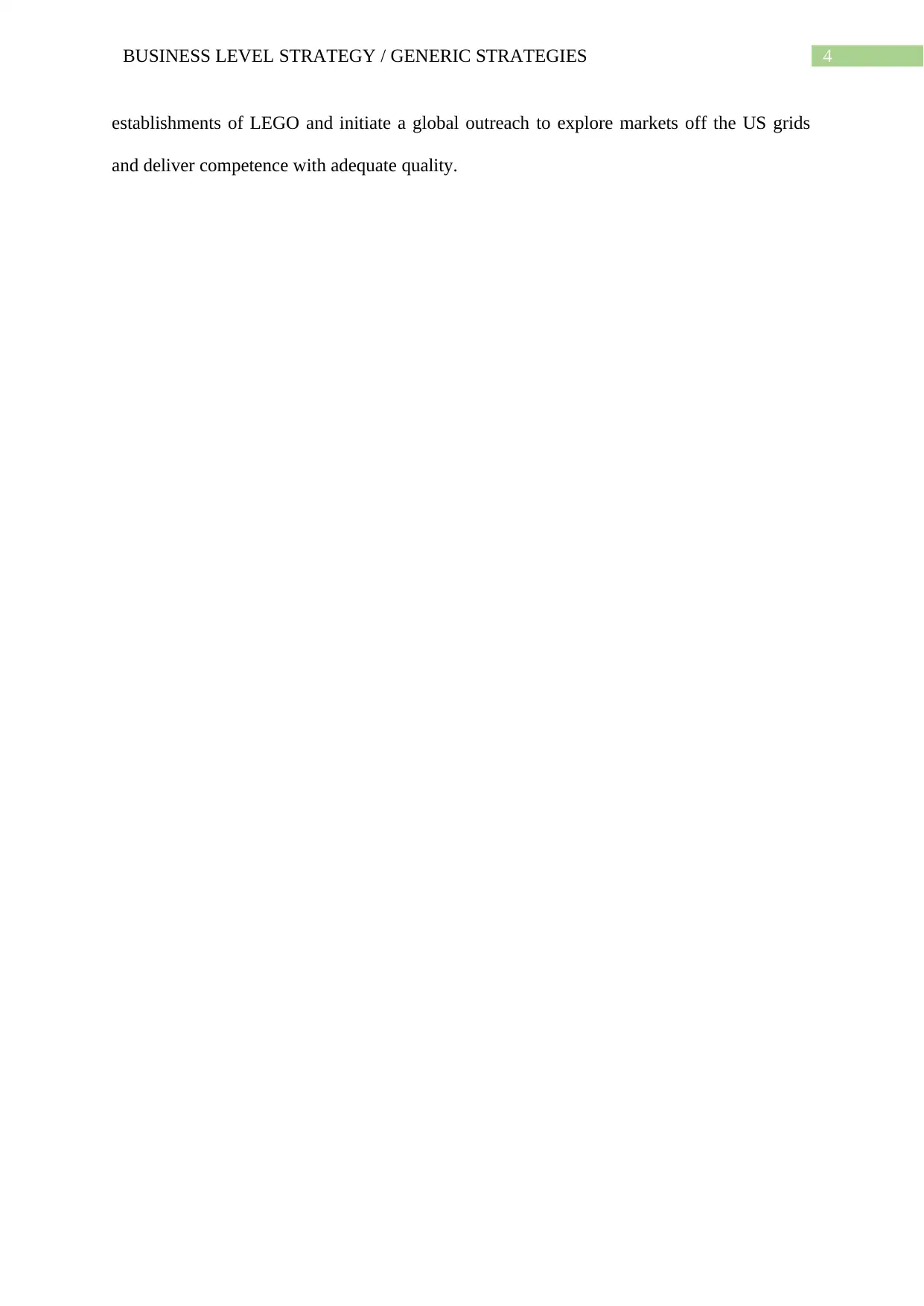
4BUSINESS LEVEL STRATEGY / GENERIC STRATEGIES
establishments of LEGO and initiate a global outreach to explore markets off the US grids
and deliver competence with adequate quality.
establishments of LEGO and initiate a global outreach to explore markets off the US grids
and deliver competence with adequate quality.
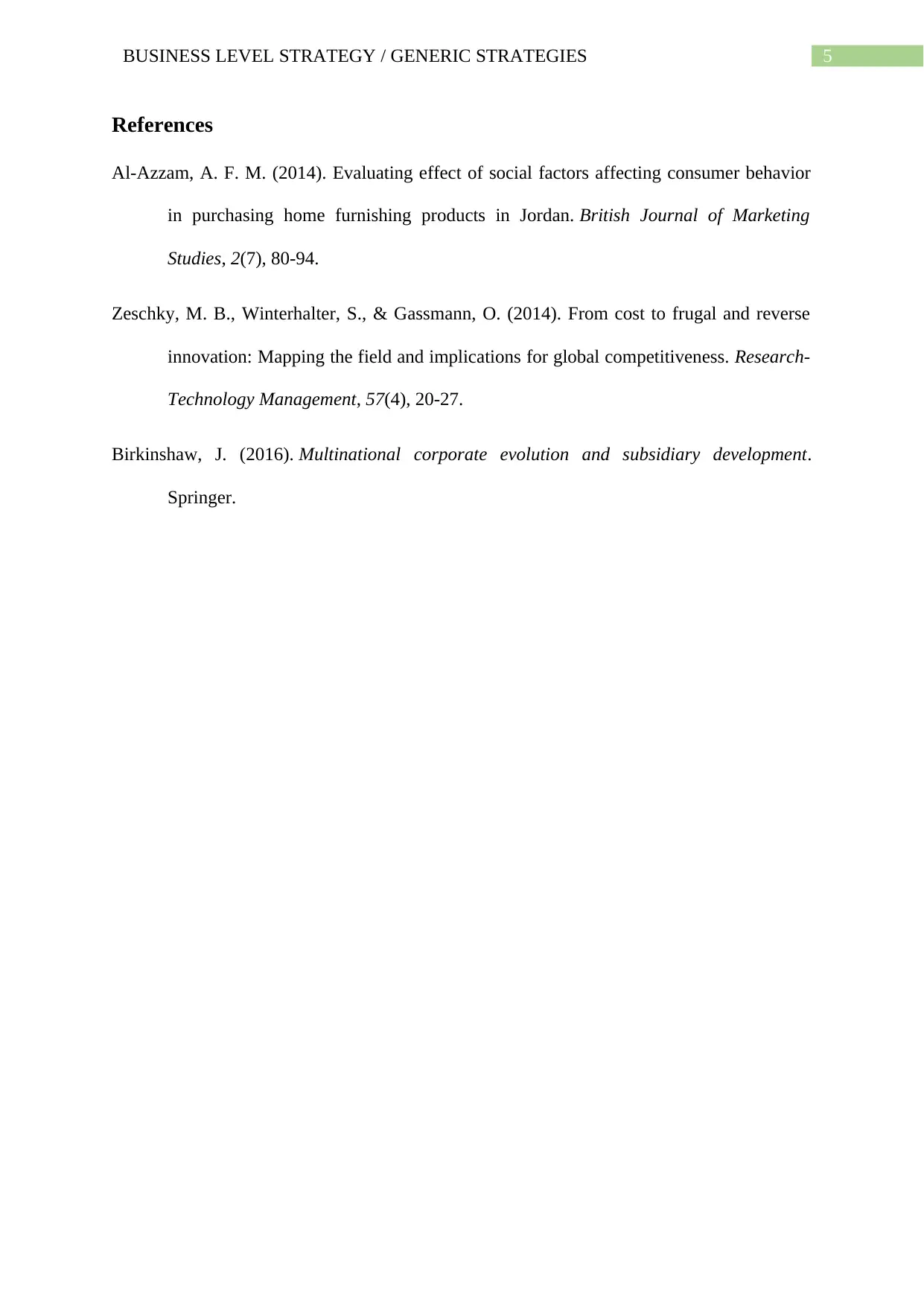
5BUSINESS LEVEL STRATEGY / GENERIC STRATEGIES
References
Al-Azzam, A. F. M. (2014). Evaluating effect of social factors affecting consumer behavior
in purchasing home furnishing products in Jordan. British Journal of Marketing
Studies, 2(7), 80-94.
Zeschky, M. B., Winterhalter, S., & Gassmann, O. (2014). From cost to frugal and reverse
innovation: Mapping the field and implications for global competitiveness. Research-
Technology Management, 57(4), 20-27.
Birkinshaw, J. (2016). Multinational corporate evolution and subsidiary development.
Springer.
References
Al-Azzam, A. F. M. (2014). Evaluating effect of social factors affecting consumer behavior
in purchasing home furnishing products in Jordan. British Journal of Marketing
Studies, 2(7), 80-94.
Zeschky, M. B., Winterhalter, S., & Gassmann, O. (2014). From cost to frugal and reverse
innovation: Mapping the field and implications for global competitiveness. Research-
Technology Management, 57(4), 20-27.
Birkinshaw, J. (2016). Multinational corporate evolution and subsidiary development.
Springer.
⊘ This is a preview!⊘
Do you want full access?
Subscribe today to unlock all pages.

Trusted by 1+ million students worldwide
1 out of 6
Related Documents
Your All-in-One AI-Powered Toolkit for Academic Success.
+13062052269
info@desklib.com
Available 24*7 on WhatsApp / Email
![[object Object]](/_next/static/media/star-bottom.7253800d.svg)
Unlock your academic potential
Copyright © 2020–2025 A2Z Services. All Rights Reserved. Developed and managed by ZUCOL.





